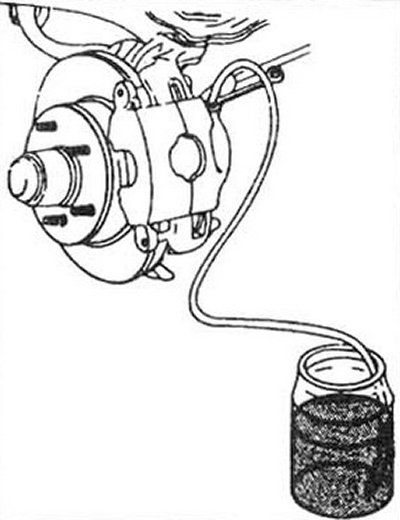Caution: If brake fluid gets into your eyes, rinse immediately with water and seek medical attention.
1. Bleeding the system is necessary to remove air that got into the system during the dismantling and installation of the components of the hydraulic part of the brakes.
2. If the brake pipe was only disconnected from the wheel, only that brake caliper or wheel cylinder needs to be bled.
3. If the tubes were disconnected from the master cylinder, bleeding of the entire system is required.
4. Release the vacuum from the brake booster by depressing the brake pedal several times with the engine off.
5. Remove the brake reservoir cap and fill it with brake fluid.
Attention: watch the fluid level in the tank during the pumping procedure. Do not allow the complete removal of liquid from the tank.
6. For work, you will need a clean container partially filled with brake fluid, a supply of brake fluid for topping up, a sufficiently long rubber or vinyl hose with an internal diameter of about 5 mm, a wrench for unscrewing the bleed valve and an assistant.
7. Start with the left front wheel. Slightly loosen the bleeder screw, tighten it and check the ease of rotation of the screw when loosening and tightening.
8. Put a hose on a tip of the union of prorolling and immerse its other end in capacity with a brake liquid.

Pic. 10.8 Preparing to bleed the brake circuit
9. The assistant should press the brake pedal several times and hold it in the lower position after you feel resistance from pressure.
10. With the pedal depressed, unscrew the bleed valve so. to allow fluid to flow through the hose. Wait for all air bubbles to come out, tighten the fitting.
11. Repeat steps 9 and 10 until. until no more air bubbles come out of the tube. Tighten the bleeder screw and go to the right rear wheel, then to the right front wheel and. finally, to the left rear. Constantly check the fluid level in the brake reservoir.
12. Do not use fluid from the brake fluid collection container for topping up.
13. Add fluid to the reservoir at the end of the bleeding operation.
14. Check the operation of the brakes: the pedal must be "tough" at the end of the braking stroke.
